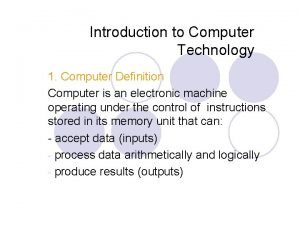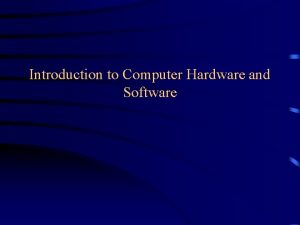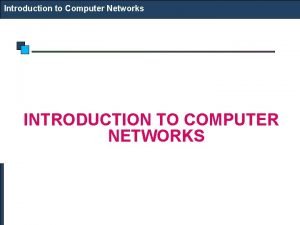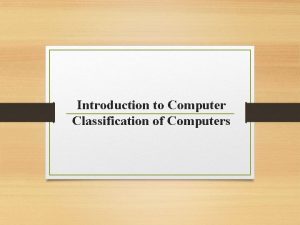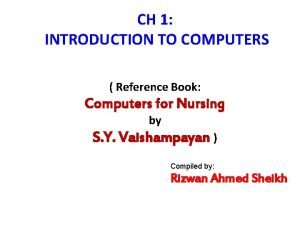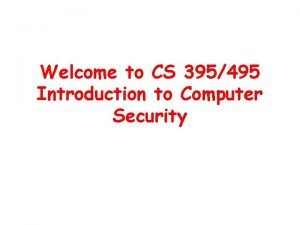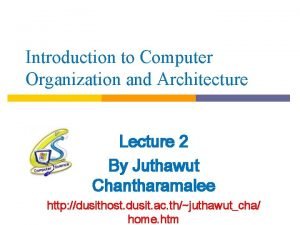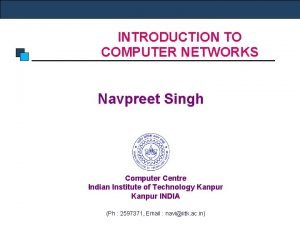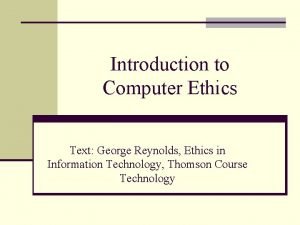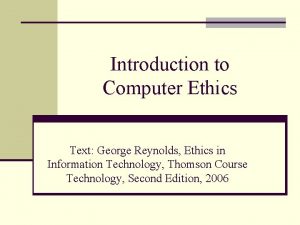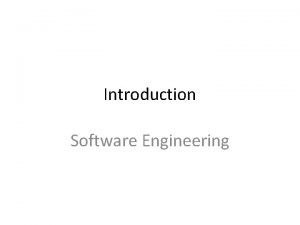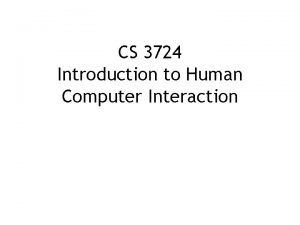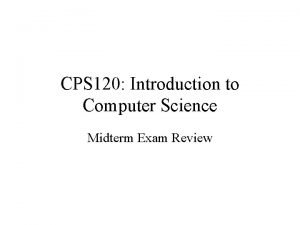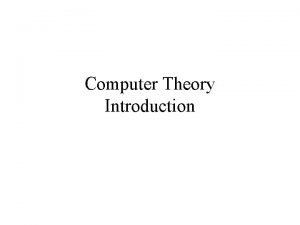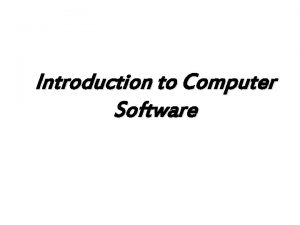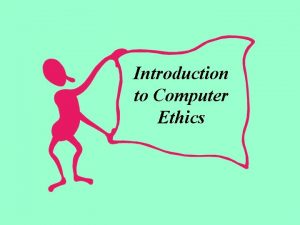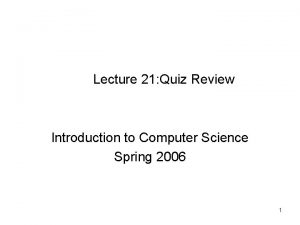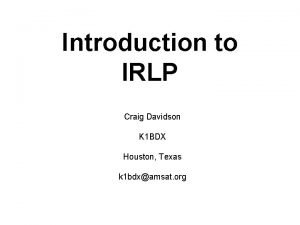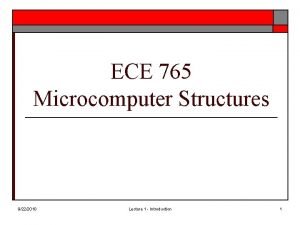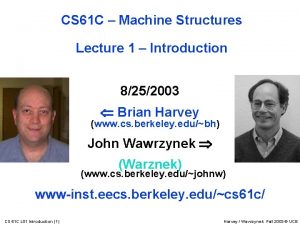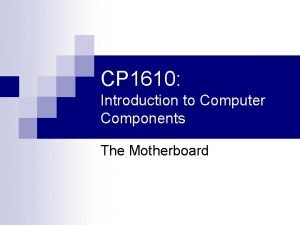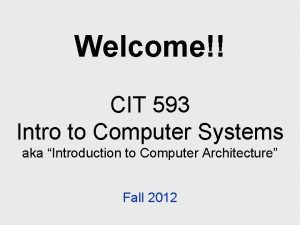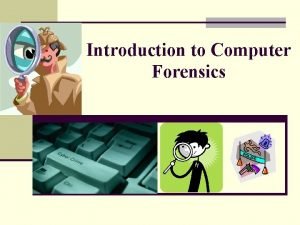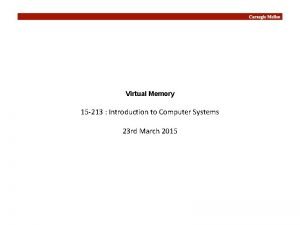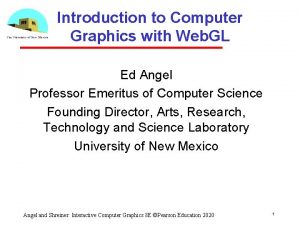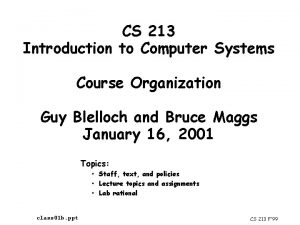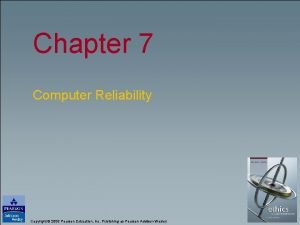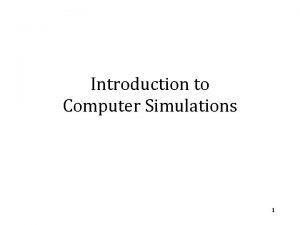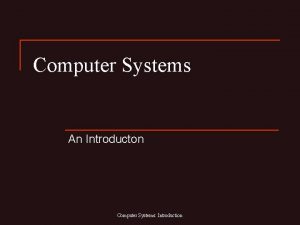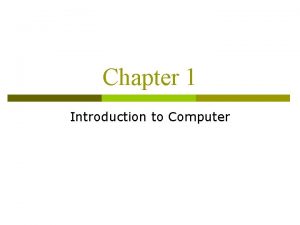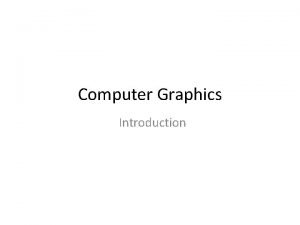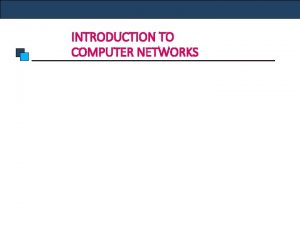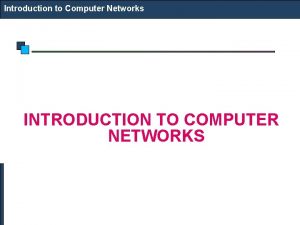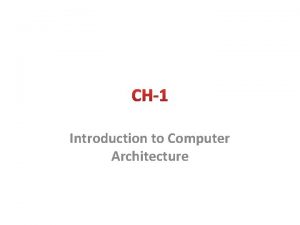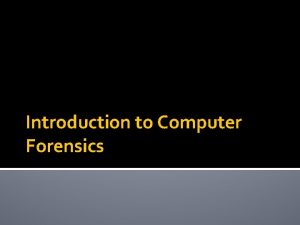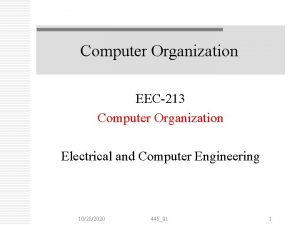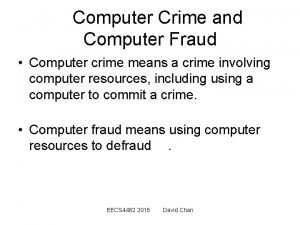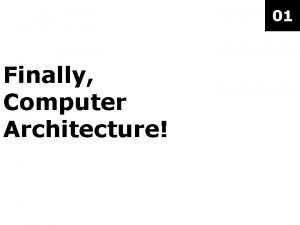Introduction to 2 D and 3 D Computer







































- Slides: 39

Introduction to 2 D and 3 D Computer Graphics Realistic Rendering -- Solids Modeling -- CS 447/547 10 - 1

Building Realistic. . . Objects using solid modeling § Solid objects can be defined. . . –. . . by sweeping an object along a trajectory through space –. . . this process is called extrusion § Extrusion. . . –. . . is a natural way to represent objects made of extruding metal or plastics with cross-sections visible –. . . can be performed using translational sweeps or CS 447/547 10 - 2 rotational sweeps

Building Realistic. . . Objects using solid modeling § Translational sweeps. . . –. . . are a simple sweep defined by a 2 D area swept along a linear path normal to the plan of the area, creating a volume § Rotational sweeps. . . –. . . are defined by rotating around a 2 D area about an axis CS 447/547 10 - 3

Building Realistic. . . Objects using solid modeling 2 D area CS 447/547 10 - 4 Translation sweep Rotational sweep

Building Realistic. . . Objects using solid modeling § Quadric surfaces. . . –. . . are defined by quadratic equations in twodimensional space –. . . for example, can be spheres and cones –. . . are also called surfaces of revolution, since a finite curve in two dimensions is swept in threedimensional space about one axis to create the surface CS 447/547 10 - 5

Building Realistic. . . Objects using solid modeling § Quadric surfaces. . . –. . . where a circle centered on the origin forms a sphere, otherwise it forms a torus –. . . where a line with one end on the axis of rotation forms a cone, a line parallel to the axis of rotation forms a cylinder § Render. Man™ always uses the z axis as the axis of rotation, with a sweep angle. . . –. . . sweeping a quadric by less then 360 degrees leaves CS 447/547 10 -an 6 open surface

Building Realistic. . . Objects using solid modeling • Example quadric surfaces. . . Torus Sphere Cone CS 447/547 10 - 7 Disk Cylinder

Building Realistic. . . Objects using solid modeling § To make a realistic image. . . –. . . objects must be able to be combined § One of the most popular ways for combining objects. . . –. . . is with Boolean set operators –. . . using union, difference, and intersection § Boolean set operators are 3 D equivalents of simple 2 D CS 447/547 10 - 8

Building Realistic. . . Objects using solid modeling Two intersecting cubes CS 447/547 10 - 9 Union operation Intersection operation Difference operation: Bottom-Top Difference operation: Top-Bottom

Building Realistic. . . Objects using solid modeling § Using ordinary Boolean set operators, not all intersections form solid objects. . . –. . . they may instead form a plane, a line. . . Two intersecting cubes producing a solid CS 447/547 10 - 10 Two intersecting cubes producing a plane Two intersecting cubes producing a line

Building Realistic. . . Objects using solid modeling • Or. . . they may instead form a point or be null Two intersecting cubes producing a point CS 447/547 10 - 11 Two cubes producing a null set

Building Realistic. . . Objects using solid modeling § Using regularized Boolean set operators, only solid objects or null sets are formed. . . –. . . let's look at the same set of examples using regularized operators: Two intersecting cubes producing a solid CS 447/547 10 - 12 Two intersecting cubes producing a null set

Building Realistic. . . Objects using solid modeling Two intersecting cubes again producing a null set CS 447/547 10 - 13 Two cubes producing a null set

Building Realistic. . . Objects using solid modeling § Solid objects created with sweeps can be manipulated using Boolean set operations. . . –. . . by first converting the objects into boundary representations, spatial-partitioning representations, or constructive solid geometry Two simple sweeps of 2 D objects (triangles) CS 447/547 10 - 14 How these objects would look when overlapping The result of a union operation; it can no longer be thought of as a simple sweep

Building Realistic. . . Objects using solid modeling § Boundary representations. . . –. . . are called b-reps –. . . describe objects in terms of their surface boundaries: vertices, edges, and faces –. . . are generally restricted to be planar, with polygonal boundaries and convex faces –. . . are generally restricted to be 2 -manifolds: this means that support is not provided when there are more than 2 faces sharing an edge and neighboring points on each of the faces are not continuous CS 447/547 10 - 15

Building Realistic. . . Objects using solid modeling § Boundary representations. . . Face Vertex Edge CS 447/547 10 - 16 This object has boundaries that are 2 -manifold: each point on a face has a neighborhood of surrounding points that is a topological disk Notice in this case, there is an edge that has neighboring points from 4 faces that does not create a topological disk

Building Realistic. . . Objects using solid modeling § Boundary representations of simple polyhedra. . . – are described by Euler's formula –. . . are solids bounded by a set of polygons, but can be deformed into a sphere and has no holes –. . . follow the rules: Vertices-Edges+Faces=2 CS 447/547 10 - 17

Building Realistic. . . Objects using solid modeling § To guarantee that a solid volume is created. . . –. . . each edge must connect to two vertices and be shared by exactly two faces, –. . . at least three edges must meet at each vertex, and –. . . faces must not interpenetrate one another 5 Faces 6 Vertice 9 Edges CS 447/547 10 - 18 8 Vertice 6 Faces 8 Vertice 12 Edges Example simply polyhedra where V-E+F=2 14 Edges

Building Realistic. . . Objects using solid modeling § Boundary representations of polyhedra with holes. . . –. . . are described by a generalization of Euler's formul –. . . Vertices-Edges+Faces-Holes=2(Separateparts-Genus) –. . . where Holes describes the # of holes in the faces –. . . where Genus describes the # of holes that pass through the object –. . . where Separate parts describe the # of separate components in the object CS 447/547 10 - 19

Building Realistic. . . Objects using solid modeling § Boundary representations of polyhedra with holes. . . 3 Holes (1 of them is in the bottom face) 15 Faces 1 Separate Parts 1 Genus 24 Vertice A polyhedron with a hole passing through the object 36 Edges CS 447/547 10 - 20

Building Realistic. . . Objects using solid modeling § Spatial-partitioning representations. . . –. . . describe objects as collections of adjoining nonintersecting solids § Spatial-partitioning creates collections of solids that. . . –. . . may or may not be the same type as the original object –. . . are like building blocks –. . . can vary in type, size, position, parameterization, and orientation CS 447/547 10 - 21

Building Realistic. . . Objects using solid modeling § Solid objects can be formed with spatialpartitioning using. . . –. . . cell decomposition –. . . spatial-occupancy enumeration –. . . octrees and quadtrees, etc. CS 447/547 10 - 22

Building Realistic. . . Objects using solid modeling § Cell decomposition. . . –. . is a popular form of spatial-partitioning –. . . composes complex objects from simple primitives in a bottom-up fashion by gluing them together! (like a union but without objects intersecting) –. . . composes objects from cells, where any two cells must share a single point, edge, or face CS 447/547 10 - 23

Building Realistic. . . Objects using solid modeling § Cell decomposition. . . Three simple primitives: called cells CS 447/547 10 - 24 Keep in mind with this method, that the complex object can be created using cells in more than one way. . .

Building Realistic. . . Objects using solid modeling § Spatial-occupancy enumeration. . . –. . . is a special case of cell decomposition –. . . defines objects using identical cells arrayed in a fixed and regular grid (called voxels) –. . . most commonly uses a cube cell type –. . . only controls whether or not a cell is present or absent in every cell in a grid –. . . no other controls are defined –. . . creates unique and unambiguous list of CS 447/547 10 - 25 occupied cells

Building Realistic. . . Objects using solid modeling § Spatial-occupancy enumeration. . . CS 447/547 10 - 26

Building Realistic. . . Objects using solid modeling § Octrees. . . –. . . are a hierarchical way to use voxels –. . . are designed to reduce the storage requirements of the spatial-occupancy enumeration approach –. . . are derived from 2 D quadtrees. . . and expanded to 3 D CS 447/547 10 - 27

Building Realistic. . . Objects using solid modeling § Quadtrees. . . –. . . successively subdivide a 2 D plane in both dimensions –. . . where each quadrant is full, partly full, or empty depending on how much of the complex object intersects the area –. . . where partly full quadrants are recursively subdivided –. . . and subdivision continues until all cells are CS 447/547 10 - 28 full or empty

Building Realistic. . . Objects using solid modeling • Quadtrees. . . Cells (voxels) using spatial-occupancy enumeration CS 447/547 10 - 29 Cells using quadtrees

Building Realistic. . . Objects using solid modeling 2 3 0 1 For example. . . 2 3 0 1 0 3 3 Full 0 Empty 0 1 2 1 Full 0 Empty 3 1 Full CS 447/547 10 - 30 2 Empty Full

Building Realistic. . . Objects using solid modeling § Octrees. . . –. . . are three dimensional quadtrees –. . . its three dimensions are recursively subdivided into octants –. . . have quadrants: CS 447/547 10 - 31

Building Realistic. . . Objects using solid modeling § § Octrees. . . The number of nodes in a quadtree or octree is proportional to the object's perimeter or surface, respectively –. . . this is because subdivision occurs only from the need to represent an object's boundary –. . . therefore, subdivision only occurs in those quadrants where a boundary passes CS 447/547 10 - 32

Building Realistic. . . Objects using solid modeling § Boolean set operators can also apply to both quadtrees and octrees. . . –. . . by traversing the two trees in parallel CS 447/547 10 - 33 Object #1 Object #2 Union operation Intersection operation

Building Realistic. . . Objects using solid modeling § Constructive solid geometry (CSG). . . –. . . describes objects in terms of regularized Boolean set operators (as part of their representation) –. . . stores objects in a tree with operators at the internal nodes and simple primitives at the leaves –. . . allows nodes to represent Boolean operators, translation, rotation, or scaling CS 447/547 10 - 34

Building Realistic. . . Objects using solid modeling § Some implementations limit the primitives to be simple solids -- like cubes or spheres. . . –. . . other implementations allow objects that aren't even completely bounded volumes! These are useful for slicing an object by a plane § CSG does not provide unique representation. . . – and therefore can be confusing for systems that allow "leaf" editing (for adding, deleting, CS 447/547 10 - 35 replacing, and modifying subtrees)

Building Realistic. . . Objects using solid modeling • A CSG example: Union, Rotate Translate CS 447/547 10 - 36

Building Realistic. . . Objects using solid modeling: summary § Accuracy. . . –. . . is best achieved by CSG that allows for curved surfaces –. . . is only approximated using spatial-partitioning and polygonal b-rep methods § The variety of objects represented. . . –. . . is best achieved using spatial-partitioning since they can represent any solid (even if it is an approximation) CS 447/547 10 - 37

Building Realistic. . . Objects using solid modeling: summary § The variety of objects represented. . . –. . . can also be achieved using b-reps, if they provide faces and edges in addition to polygons bounded by straight lines –. . . is limited using sweeps § Uniqueness. . . –. . . can be guaranteed only using octree and spatialoccupancy enumeration methods CS 447/547 10 - 38

Building Realistic. . . Objects using solid modeling: summary § Compactness and efficiency. . . –. . . are best achieved using CSG, since it is compact and able to record Boolean operations and transformations quickly CS 447/547 10 - 39
 Objective of computer system
Objective of computer system What is computer organization
What is computer organization Monitor printer speaker and projector are blank devices
Monitor printer speaker and projector are blank devices Difference between architecture and organization
Difference between architecture and organization Introduction to computer organization and architecture
Introduction to computer organization and architecture Computer technology introduction
Computer technology introduction Introduction to computer software
Introduction to computer software Basic structure of a computer
Basic structure of a computer Basic computer design
Basic computer design Basic computer organisation and design
Basic computer organisation and design Introduction to computer
Introduction to computer Classification of computer
Classification of computer Dot matrix display ppt
Dot matrix display ppt Introduction to computer reference books
Introduction to computer reference books 395495
395495 Subroutine in computer architecture
Subroutine in computer architecture Introduction computer centre
Introduction computer centre Introduction of computer ethics
Introduction of computer ethics Introduction to computer ethics
Introduction to computer ethics Computer software introduction
Computer software introduction Introduction of computer
Introduction of computer Introduction to computer science midterm exam
Introduction to computer science midterm exam Introduction to computer science midterm exam test
Introduction to computer science midterm exam test Accounting software conclusion
Accounting software conclusion Introduction to computer theory
Introduction to computer theory Ctrl c ctrl v
Ctrl c ctrl v Logical malleability
Logical malleability C++ code
C++ code Introduction to personal computer
Introduction to personal computer Introduction to personal computer
Introduction to personal computer Introduction to personal computer
Introduction to personal computer Motherboard introduction
Motherboard introduction Mcit 593
Mcit 593 Python programming an introduction to computer science
Python programming an introduction to computer science Computer crime
Computer crime Computer graphics ppt
Computer graphics ppt 15-213 introduction to computer systems
15-213 introduction to computer systems Introduction of computer education
Introduction of computer education 15-213 introduction to computer systems
15-213 introduction to computer systems Introduction of computer education
Introduction of computer education





